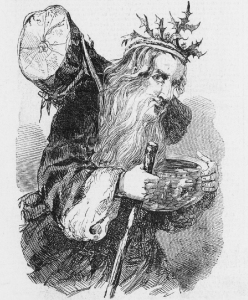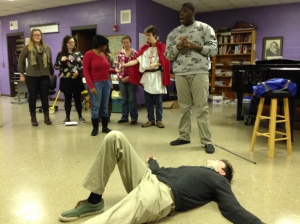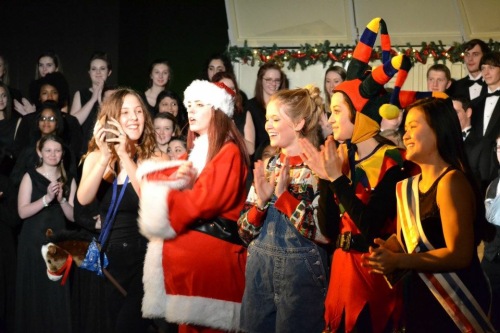Producing a Student Mummer’s Play
Part of a series of articles on
Preparing a School Winter Solstice Performance
The student mummer’s play presents the music teacher or choir director with a unique and wonderful element to program as part of the annual winter solstice performance: a short comical play that imparts the message of the season, with deep historical roots – featuring your students in all of the roles. Here are some tips and guidelines to help you pull this wonderful little drama together.
Choose a script
The scripts here were developed for two different age groups:
- Fieldston Outdoors Mummer’s Play (upper elementary school)
This script was originally written for upper elementary school students – 5th and 6th graders (9-11 year olds) at Fieldston Outdoors summer camp in the Bronx. I later produced it as the CDS Mummer’s Play with my 5th grade students at Carrollwood Day School.
Note: this play was not intended in either version to be performed for the winter solstice, and does not include Father Christmas. Teachers intending to use a mummer’s play for their elementary school performance may wish to amend this script and add the Father Christmas character (and at least some of his lines) from the NSA Mummer’s Play.
- Nashville School of the Arts Mummer’s Play (middle and high school)
This script was adapted from the Linden Corner School Mummer’s Play which I produced with a cast of 7th and 8th grade students (11-13 year olds). The NSA play is longer than the Fieldston Outdoors Mummer’s Play – there are more lines to memorize for each character and the interaction between the characters will require more rehearsal to present effectively in performance. At NSA this play was presented enthusiastically each year by a cast of juniors and (mostly) seniors: 16-18 year olds.
Set a timeline
Plan a timeline by working backwards from your performance date. Ideally, you should begin preparations for your mummer’s play in earnest about 6-8 weeks before the performance. That said, this is a short play and can be pulled together much more quickly if necessary.
The rehearsal process is pretty straightforward. Here is a description of how I pulled the play together at NSA each year:
We would usually begin to work on it the second week in October (after students returned from Fall Break), and put on the performance the first Thursday night in December.
- casting (6-8 weeks before the performance)
- blocking (4-6 weeks before the performance)
- scene rehearsals (3-5 weeks before the performance)
- memorization (2-3 weeks before the performance)
- full run-throughs (2-4 weeks before the performance)
- incorporate props and costumes (2-3 weeks before the performance)
- dress rehearsal (week of the performance)
All of this had to be done during the time in which the choirs were feverishly rehearsing and preparing the rest of the program. The mummer’s play became a traditional province of the older students in the program, with casting preference given to seniors (12th graders). In practice, I let students in the two advanced choirs audition and everyone who auditioned got a part (even if only a Townsperson with a couplet to recite). Most of the roles were played by seniors each year, but there were always juniors (11th graders) who participated as well.
I would distribute copies of the script to every student who expressed the wish to audition with a firm injunction to keep it secret – we rehearsed the mummer’s play out of sight of the rest of the students, who only saw it at the dress rehearsal (so they could learn the choir’s cues) and the performance. Not allowing students who weren’t cast members to witness the rehearsals helped the play retain its aura of mystery, or at least, kept the other students wondering: what in the world are they doing?
Auditions were held within a week after I gave out the scripts, after school or at lunch time. Usually I could cast the play after a one hour session of auditions, but occasionally would have to hold more than one audition time so that every student who wished to audition had the opportunity. Students auditioning acted out scenes from the play (scripts in hand), taking turns playing the different parts and playing scenes from the play with each other. I tried to see each student play several different roles, and made sure they had a chance to audition for a specific part, if there was one they wanted.

NSA Mummers 2013: (l to r) Hobby Horse, Fool, Johnny Jack, Father Christmas, Dragon ~ photo courtesy of Madison Atkins
As the director, the one thing I found myself doing with the student actors – right from the beginning with the first auditions – was exhorting them to play everything bigger, with more gusto and exuberance. I don’t believe the mummer’s play can be overacted! – at least with students. The humor is very obvious, ridiculous, and sometimes slapstick, and needs to be presented as broadly as possible. So often I found myself stopping them and either asking them for more or demonstrating for them myself, saying the lines in the biggest, most physical, and most outlandish manner.
Once the play was cast, students were told to begin to memorize their parts immediately and given a deadline by which to do so (usually three weeks before the show). Our performance took place on the first Thursday in December – falling exactly a week after Thanksgiving in the U.S. So in practice, almost no work could be done the week before the week of the performance due to the holiday, and really it needed to be ready perform by the Friday nearly two weeks before the performance. Having the memorization deadline a week earlier than this gave the students one week to rehearse without allowing them scripts in their hands.
 The first rehearsals were blocking rehearsals – directing where, when, and how the actors move during the play – and usually it took a couple of rehearsals to block the whole play. Our mummer’s play had to be performed in a tight space in front of the choir without a lot of room to move around, and students who had little theatre experience had to be constantly reminded to face the audience, how to speak to the audience even when engaged in dialogue with the other characters, etc. The play does require a bit of choreography – there is a very silly little song and “dance” which the Fool and Johnny Jack perform near the beginning, and a brief fight between St. George and the Dragon to stage.
The first rehearsals were blocking rehearsals – directing where, when, and how the actors move during the play – and usually it took a couple of rehearsals to block the whole play. Our mummer’s play had to be performed in a tight space in front of the choir without a lot of room to move around, and students who had little theatre experience had to be constantly reminded to face the audience, how to speak to the audience even when engaged in dialogue with the other characters, etc. The play does require a bit of choreography – there is a very silly little song and “dance” which the Fool and Johnny Jack perform near the beginning, and a brief fight between St. George and the Dragon to stage.
For an example of one way to block the student mummer’s play, watch this video of the 2014 NSA Mummer’s Play:
A link to the video of the Linden Corner School Mummer’s Play is provided in In Comes I: The Student Mummer’s Play, the introductory article in this series.
Due to the timing of our winter solstice performance at NSA, I would try to begin full run-throughs of the play by the second week of November at the latest. The play itself is short. A lot of its effect despond on timing, and how secure the students feel with their lines. The cast was encouraged to get “off book” as quickly as possible and no later than the deadline, and also (especially for characters whose action depended on them) to acquire and begin practicing with their props as soon as possible. By three weeks before the performance, we would try to be running through the entire play – often twice in a rehearsal – several times per week, in a half hour stolen during lunch time or immediately after school.
Costumes & Props
I required each student cast in the mummer’s play at NSA to be responsible for gathering his or her own costume and all the props needed. This was simple expediency: there were so many moving parts in the winter solstice performance that I couldn’t possibly manage to come up with props and costumes as well. When I produced mummer’s plays with younger students, often we had help from parents who were particularly interested in costumes help us with wardrobe (I was fortunate to have several students whose mothers were amazing seamstresses!) and assistance from art teachers or other members of school staff.
Here are a few notes on the characters, their costumes, and the props required:
Fool
The Fool is ironically the most serious of all the characters in the mummer’s play, and ultimately is the only one able to come up with a cure to bring the Dragon back to life. The Fool’s costume should evoke associations with the traditional medieval King’s Fool or Jester – a costume in motley is very appropriate! Several students who played the Fool had elaborate jester costumes over the years, but a few small simple touches can also provide a distinct costume for this character, such as a floppy hat or a scalloped collar cut from colorful felt.

‘Christmas with the Yule Log’, Illustrated London News, 1848.
“WHAT? Father Christmas! here again?
With Yule Log on your back,
And mighty store of racy things
Well stuffed within your pack”.
Father Christmas
This character is the personification of Christmas, and may be costumed in the English manner – wearing a long robe and a crown of holly leaves – or as the American Santa Claus. Either costume should sport a long white beard. In our NSA mummer’s plays, this character was played by girls who somehow always ended up pulling the beard down below their chins.
Johnny Jack
Johnny Jack is a simpleton, and wears a basket or pack on his back, from the top of which emerge the heads of a few dolls representing his family. In the Fieldston Outdoors Mummer’s Play, Johnny Jack says “My wit is here, sharp as a tack” and removes his cap to reveal a sharp “conehead” prosthesis (i.e. a paper cone with scraps of brown yarn glued to it to simulate hair and fastened with a chinstrap), but I removed this line – and the need for this costume detail – when I rewrote the play for Linden Corner.
Johnny Jack needs a broom, which he brings with him on stage, and over which he has a brief tug of war with the Fool.
Hobby Horse
This character may be portrayed simply – by the actor playing him carrying a child’s hobby horse (a model horse head on a stick). A more elaborate costume may also be devised involving a skirted hoop worn around the waist (hung from the shoulders by suspenders) to which is affixed the horse head model. This costume was usually favored by the actors who played the Hobby Horse in my productions, perhaps because the Hobby Horse thus-costumed was then one of the most unusual- and ridiculous-looking members of the troupe.
Dragon
The fire-breathing, reptilian villain. Usually our Dragons were green – but a fine dragon costume could also be put together in red or orange, or even blue! My main concern with this costume was that the dragon’s head not mask the actor’s face, so that all lines could be heard clearly and the child’s facial expressions seen. To accomplish this, the dragon’s head can be “built” (out of stuffed felt, for example) on top of a baseball cap, or on the hood of a jumpsuit, or could simply be suggested by makeup. This Dragon should have a tail! which also serves as a prop for the Dragon to swish and gesture with, and to counter St. George’s sword with when they duel.
Mayor/King
This character is nominally the authority figure of the troupe. The Mayor is the simplest of the mummer’s costumes to provide – a simple elegant sash decorated with the word “Mayor” worn over one shoulder will do nicely, or even a big medal hung with colorful ribbons pinned to the actor’s lapel.
In the Linden Corner School Mummer’s Play, and in one of our NSA Mummer’s Play productions, I replaced the Mayor with Good King Wenceslas. “GKW” was a lead character in The Feast of Stephen, and in both of these winter solstice productions the King and the Fool acted out the title carol as it was sung by the choir. The King’s lines in the play are nearly identical to the mayor’s – but his costume should be evocative of a benevolent medieval monarch, complete with robe, beard, and crown.

Woodcut of St George Slaying the Dragon from Life of Saint George, 1515, by Alexander Barclay (1476-1552)
Saint George
Our hero should be costumed as a medieval crusader: white tunic adorned with the red cross of St. George (naturally). He needs a (wooden or plastic child’s) sword, preferably in a scabbard hung form his belt. A shield is optional and may get in the way of the actor’s movement – we usually did without this detail. If St. George wears a helmet, be certain it does not cover the child’s face, or that he takes it off before beginning to deliver his lines.
Doctor
The Doctor in our plays always wore a white lab coat: the contemporary doctor costume. But there isn’t really a reason that the Doctor couldn’t wear a more rustic outfit, as long as it gives the impression of some kind of professionalism (at first, anyway). Any number of details could dress up the Doctor’s costume too: stethoscope, headlamp, and other accessories can help complete the ensemble.
Indispensable, however, is the doctor’s bag, and if it’s possible to find one, the traditional (antique) black medical bag is best. Into this bag go most of the props used in the mummer’s play: the Doctor’s gags.
These gags are simply silly things the Doctor pulls out of his bag when he is looking for his pills (you’ll need two pill bottles for these, also: we found Tic Tac mints to be a fun prop!).
The gags: things I have seen the Doctor pull out of his bag in our plays included dolls, boxer shorts (usually decorated with something silly or only slightly provocative), a rubber chicken, and scarves: many, many scarves tied together end-to-end so that removing them from the bag takes a long time and ends up with all the mummers holding the chain of scarves together. Use your imagination! – and keep it clean.
In addition, it’s a good idea to have a pair of finger cymbals or a glockenspiel for another mummer or someone off stage to make sound effects for the Doctor’s “treatments”.
Townspeople
Townspeople can be dressed in (medieval burgher or villager) costume if called for by your winter solstice production, or they can simply be members of the choir who step forward and say their lines.
Recruit a small child – a kindergartener is ideal – to be your ringer in the audience whom the Fool “finds” at the end of the play, leads to the stage, and cures the Dragon with a kiss. Arrange for this child to come to the dress rehearsal or a rehearsal as close to the performance as possible and practice his or her part – and be prepared to improvise! Under pressure, in front of an audience, it may be difficult even with preparation for your young miracle worker to actually pull through (as seen in the video above).
Have fun! And let me know if you put on this delightful little play with your students.
NEXT: Fieldston Outdoors Mummer’s Play
* * *
Preparing a School Winter Solstice Performance:
Christmas in July <– START HERE
In Comes I: The Student Mummer’s Play
We Come To Show Activity: Producing a Student Mummer’s Play





[…] We Come To Show Activity: Producing a Student Mummer’s Play […]
[…] We Come To Show Activity: Producing a Student Mummer’s Play […]
[…] We Come To Show Activity: Producing a Student Mummer’s Play […]
[…] We Come To Show Activity: Producing a Student Mummer’s Play […]
[…] We Come To Show Activity: Producing a Student Mummer’s Play […]
[…] We Come To Show Activity: Producing a Student Mummer’s Play […]
[…] We Come To Show Activity: Producing a Student Mummer’s Play […]
[…] We Come To Show Activity: Producing a Student Mummer’s Play […]
[…] We Come To Show Activity: Producing a Student Mummer’s Play […]